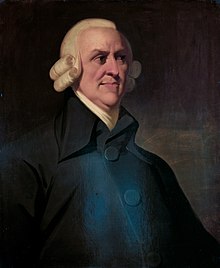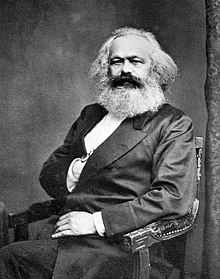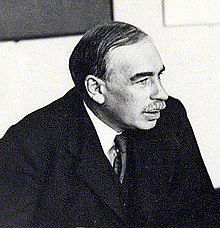The Three Most Cited Economists
Why Should I Care?
These guys are dead. But their ideas are still relevant to this day. What they wrote about economics is at the heart of our most controversial issues and debates. Free trade, recession, poverty… These three thinkers will help give you a better grasp of many of today’s pressing issues.
This Lecture Has 3 Parts
- Adam Smith and the Liberals
- Karl Marx and the Marxists
- John Maynard Keynes and the Keynesians
Who are the Three Most Cited Economists?
These three economists are the most cited economists in the history of the discipline. A school of thought is like a school of fish! It is a group of people who think the same way about something. In economics, the main schools of thought are Classical, Marxist and Keynesian. In this chapter, we will discuss their main themes, key economic ideas, and their views on the role of the state in the economy, and if a free market is good or bad for peoples’ well-being.
-
Adam Smith and the Liberals
Adam Smith tried to understand the economy in order to achieve a level of prosperity which would improve the lives of the majority of citizens. In this regard, Smith is a classical economist and was most interested in the general well-being of the population. Although Smith was not the first economist, his works were instrumental in focusing especially on economic ideas. Many regard him as the father of political economy, an approach that incorporates the study of institutions, culture, political ideas, with economic analysis.
Smith believed that the market economy regulates itself. In this regard, he is viewed as a liberal economist, and in the 1990's, free-market thinkers who revived Smith's legacy were called neo-liberal economists. He believed that when there are shortages, price increases will convince suppliers to produce more. He believed this system was fair and efficient.
He also argued for a strong role for the State, to provide public schools and roads. In this regard, he would not have agreed with libertarians who argue the State should be eliminated (or almost) from the economy.
One of Smith's most important contributions, is to argue that capital investment and innovation were the keys to economic growth and prosperity. This contradicted views that the accumulation of money (gold) was the only explanation of the wealth of nations.
Also, he argued that it was not immoral for individuals to pursue their own self-interest. This was very controversial at his time (1723 – 1790) and remains to be today. Smith argued that free-markets are a good thing because in the end, the system enables people to satisfy most of their wants and needs.
Smith coined the term Invisible Hand. Although the market economy may seem chaotic, he believed that the self-regulation of the economy did produce the right quantities at the right prices. He saw patterns where others saw chaos. He referred to an “invisible hand” that sets these prices and quantities without intervention from the State.
Division of labour is also a concept attributed to Smith. From visits to manufacturing plants, he noticed that new machinery was enabling workers to specialize more than before. He argued that production would increase if workers specialize in specific – albeit sometimes repetitive and boring – tasks. Smith uses an illustration of this, which has become widely known as the “pin story”. In the previous age of workshops, pins and nails were made from scratch at the same workstation. A pin was finished before the next one was made.
In the new age of factories, innovative machines were accelerating the pace of production. Each machine needed to be handled by a machinist. And each machine could execute only one task, over and over again. In this age of factories – the Industrial Revolution – the steps of production for many products, such as pins, were divided. The first worker cut a length of thin metal rods. The second worker milled the tips of the rods into a point. The third worker hammered out the pin heads. The fourth worker welded the pin rods to the heads. The fifth worker boxed the pins.
Smith observed that this new organization of labour, which depended on new machinery, increased the quantity of production immensely. More recent applications of this phenomenon were done by Henry Ford who was the first to use a rolling production line in the automobile industry, and by Michael Dell, who was the first to mass-produce personalized computer systems.
Even though he was right-wing, Smith and the Classical School of Thought believed the government should build roads and run schools. But they argued the government should not intervene in the market economy. Smith believed the market economy produced socially acceptable outcomes.
-
Karl Marx and the Marxists
Karl Marx (1818–1883) may be one of the most cited economists in history. Marx is considered a classical economist, because he adhered to the aim of the well-being of the population. Marxian economics are based in classical concepts, such as the principles of market self-regulation. But he believed this did not produce an economy that was good for ordinary people. Marx based his beliefs on the social reality of the Industrial Revolution in Europe.
Marx’s main argument was that in a market economy, there was an unbalance of economic power between rich and poor. These two classes, the proletariat, and the bourgeoisie, are determined by their agency in the economy. The former are paid for their labour in the form of wages. The latter are paid in capital revenue streams, such as profits and interest. It is a dialectical approach, because the bourgeoisie exists only because of the proletariat, and vice-versa. Since the theory is rooted in class structures, a meso-economic level of analysis, Marxism is considered to be part of the political economy approach to economic issues.
According to Marx's observations of the Austrian and German economies, those who owned capital used their profits to buy even more capital. They quickly dominated the labourers who earned low wages. Marx coined this phenomenon as the Surplus Value of Labour. Marx explained that workers transformed land and capital into products. These products were sold at higher prices. Marx argued workers should own this added value of their own work instead of it becoming profit for capitalists.
The problem with this situation is that workers would eventually not have enough money to buy the ever increasing quantities of products the economy would make. Due to stagnant wages, and employment levels, the lack of overall demand would create an imbalance with supply. Endemic unemployment would be the sorry outcome.
According to Marx, economic crises and unemployment due to insufficient demand are inevitable.
To help workers improve their standard of living, Marx and the Marxist School of Thought believed that money should be eliminated from domestic production, including wages. Marxists believe the government should intervene in the economy to such point that the State should own and allocate resources such as Labour, Land and Capital. This view inspired the political movement called Communism.
-
John Maynard Keynes and the Keynesians
John Maynard Keynes (1883 – 1946) is a classical economist who wrote a comprehensive theory of macroeconomics, now called Keynesian economics. He was a believer in markets, albeit critical, and only most of the time. He argued that private markets are so volatile, that they can't be trusted to provide sufficient employment to the labour force. Keynes argued the market economy needed help from government to move out of severe economic downturns. We call this Government Intervention.
Keynes based this belief on the fact that the economy, in his time, was in fact in a depression, as of 1929. These hard times lasted for a decade. Widespread unemployment had decreased regular peoples’ ability to spend (aggregate demand). This sent the economy in a tailspin of factory shutdowns and poverty. Keynes was sensitive to the negative mood of consumers and investors. He called their herd behavior “Animal Spirits”.
Keynes was opposed to the marginalist economists (Marshall, Pigou) of the time who argued that resources made idle would be eventually put to use in other sectors of the economy. They also argued that lower wages would help kick start the recovery. But Keynes argued that it would take more to put the depressed economy back on track. He argued that the whole economy was in a slump, not only a few industries, a fact most did not consider because there were no statistics to measure the entire economy at the time. He also argued that lower wages would not help to sustain the economy. In his model, Keynes assumes that wages are set by political and social factors, rather than solely by supply and demand.
Keynes proposed that the government should increase its’ spending if consumers and investors are not able to do so. Therefore, the Keynesian school of thought believes that the government should intervene in the economy. But, they do not believe the State should own or allocate resources. Keynes argued in favour of stabilization policy which includes monetary policy and government spending. He invented macroeconomics and spurred the development of macroeconomic indicators of the economy such as Gross Domestic Product, the Unemployment Rate and the Consumer Price Index.
Nowadays, Keynesian economists are divided between Neo-Keynesians, New Keynesians, and Post-Keynesians. The former have attempted to incorporate marginalist principles into their macroeconomic modelling. The Post-Keynesian school of thought is said to more closely follow the original theory.
Green Policy
Our great three thinkers were not pressed, in their time, to discuss environmental matters. Pollution, hence, was not the main point of discussion in either of these economists’ main body of work. It would be wise not to try and guess what they would have to say in today’s world. However, one would be curious to see what they would say, if one had access to a time machine.
Keynes’ work however, should be noted. He argued, in times of prolonged economic downturns, for States to borrow large sums of money and to spend the money on all sorts of projects. When asked who would pay back this debt he quipped that it did not matter, we have to act now. “In the long-run, we are all dead”, he wrote (Tract, p. 65, in Patinkin, 1975).
We can surely suppose that most economists value human life above profits. Surely.
Climate Change Solution
Again, neither Smith, Marx, nor Keynes had to tackle the issue of Climate Change. One could guess what they would have to say about it, but it’s hard to say.
One could argue however that the Keynesian macroeconomic model can be used for simulating the impacts of government spending programs aimed at any type of stimulus. A package of policies, including government spending, to reverse Global Warming, could thus be modelled using the Keynesian framework. We will look into this later.
Democracy Booster
It is interesting to note that both Smith and Marx lived in times which were drastically less democratic than today. Even Keynes, a loyal monarchist in his time, was a key advisor during World Wars I and II, periods of tyranny in Europe and across the globe.
These three thinkers, however, have one thing in common. They were trying to imagine a better world. Smith tried to explain important changes in the organization of production during the industrial revolution. Marx, tried to show a better way to organize production given the social shortfalls of industrialization. And Keynes tried his best to convince States to intervene in the economy in periods of prolonged downturns, for the betterment of many, not the few.
In the face of global warming, Marxist philosophy is gaining traction. The reason is that social inequalities have grown tremendously in the past few decades, and many people in the working class, what Marx called the Proletariat, are increasingly upset with the costs of global warming, while the wealthy elites, the Bourgeois class of the Marxist framework, have the capacity to maintain their lavish lifestyles. The 1 percent wealthiest people on the planet won't bear the brunt of the burden of a warming climate. While the rich keep flying around the world in gas-powered jets, the poor are suffering from floods and heat-waves. No wonder climate activists are intersecting with Marxist philosophy. The major caveat to all this is that Marxist politics in many parts of the world turned into totalitarian regimes, such as the USSR, and China. Marxism has a tendency to be quite seductive, especially for the disadvantaged, while being an efficient vehicle for a coup d'état.
Wrap-Up
Adam Smith is said to be the father of economics. He was pro-market, was fascinated by the division of labour in industry, the accumulation of capital, and coined the term the invisible hand. Smith was a classical liberal economist.
Karl Marx is the father of Marxism which spawned the communist political movement. He was upset about social inequalities and wished to abolish capitalism. Marxism is part of classical economics.
John M. Keynes was concerned with an ongoing recession that was not solving itself on its own. He fathered Keynesianism which convinced governments to intervene in slumping economies.
Summary Table
|
|
Adam Smith |
John M. Keynes |
Karl Marx |
|
Are market economies socially acceptable? |
YES |
YES |
NO |
|
Should the State intervene in the economy? |
NO |
YES, if recession |
YES |
|
Should the State own and allocate resources? |
NO |
NO |
YES |
|
Key Economic Idea |
Invisible Hand |
Government Intervention |
Surplus Value of Labour |
Cheat Sheet
School of Thought:
a group of academics who share similar theories the same way about something
Government spending:
increasing government expenditures to stimulate the economy.
Surplus value of labour:
the monetary added-value brought to raw materials and other resources by the act of labour. Marx argued this added-value should be turned over to workers, not to capitalists.
Invisible hand:
a metaphor used by Adam Smith to explain that markets are not chaotic, and lead to stability in prices and production.
Division of labour:
Dividing work in specialized tasks in order to increase productivity of workers. Adam Smith insisted on the importance of this phenomenon during the Industrial Revolution.
Political-Economy:
Economists who include social, political, and cultural analysis to their work in economics are considered to be conducting Political-Economy. This approach can be applied to right-wing economics, such as the Austrian school of thought, or to left-wing economics, such as Marxian economics.
Classical School of Thought:
The economists of the 18th, 19th and early 20th centuries were classically minded philosophers. Their approach to economics was focussed on improving the general quality of life of citizens, or general welfare.
Liberal or Laissez-Faire School of Thought:
Economists who are pro-market, pro-entrepreneur, pro-capital, are generally considered to be liberal economists. The term 'liberal' stems from liberty, or libre, in French, which relates to economic freedoms.
Marginalist School of Thought:
A group of economists of the early 20th century instigated the marginalist revolution. This approach emphasises variations observed at the margin, and instigated a much more mathematical method to modelling economies. Marginalists are usually liberal-minded, and oppose market constraints such as government regulations and labour unions.
References and Further Reading
Heilbroner, R. (1953). The Worldy Philosophers. Simon & Schuster, 7e édition, 1999.
Keynes, J. M. (1919). The Economic Consequences of the Peace.
Keynes, J. M. (1936). The General Theory of Employment, Interest and Money.
Marx, K. (1848). Manifesto of the Communist Party.
Marx, K. (1867). Capital. Volume I: A Critique of Political Economy, The Process of Production of Capital (Das Kapital).
Patinkin, D. (1975). The Collected Writings of John Maynard Keynes: From the Tract to the General Theory. The Economic Journal, 85 (338), 249-271.
Skousen, M. (2006). The Big Three in Economics: Adam Smith, Karl Marx et John Maynard Keynes. Armonk, NY: Routledge.
Smith, A. (1759). The Theory of Moral Sentiments.
Smith, A. (1776). An Inquiry into the Nature and Causes of the Wealth of Nations.
Thomas, A. M. (2021). Macroeconomics, An Introduction. Cambridge, UK: Cambridge University Press.




No Comments